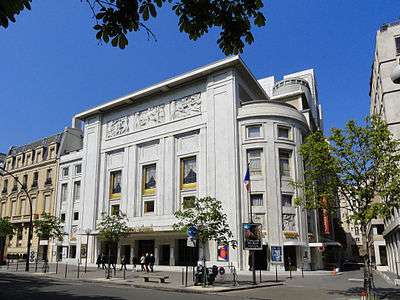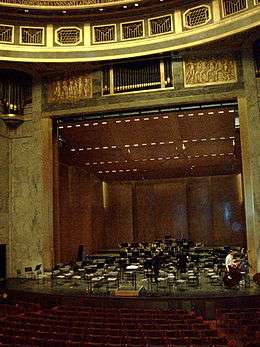Théâtre des Champs-Élysées
|
Exterior, with bas-reliefs by Antoine Bourdelle | |
| Address |
15 avenue Montaigne Paris |
|---|---|
| Coordinates | 48°51′57″N 2°18′10″E / 48.86584°N 2.3029°E |
| Owner | Caisse des Dépôts et Consignations |
| Type | Opera House |
| Capacity | 1905 |
| Construction | |
| Opened | 1913 |
| Architect | Auguste Perret |
| Website | |
| www.theatrechampselysees.fr | |
The Théâtre des Champs-Élysées is a theatre at 15 avenue Montaigne in Paris. The theater is named not after the famed Avenue des Champs-Élysées, but rather after the neighborhood in which it is situated.
Opened in 1913, it was designed by French architect Auguste Perret[1] and founded by journalist and impresario Gabriel Astruc to provide a venue suitable for contemporary music, dance and opera, in contrast to traditional, more conservative, institutions like the Paris Opera. It hosted the Ballets Russes for its first season, staging the world première of the Rite of Spring on Thursday May 29, 1913, thus becoming the celebrated location of one of the most famous of all classical music riots.[2][3]
Architecture

The Theater, constructed between 1911 and 1913, was the first example of Art Deco architecture in Paris;[4] built of reinforced concrete, and featuring rectangular forms, straight lines, and decoration attached to the outside on plaques of marble and stucco, it was a radical departure from the Art Nouveau style,[5][6][7] and, at the time, shockingly plain in appearance.
The building's concrete construction was not merely a stylistic choice. Subsoil conditions and the site's proximity to the Seine made concrete necessary. Henry van de Velde was the initial architect, resigning when it was clear that the contractors, the Perret brothers, had a far deeper understanding of the project than he did—although the Perrets were not licensed architects and had another designer, Roger Bouvard, sign their plans.[8]
The building includes an exterior bas relief by Antoine Bourdelle, a dome by Maurice Denis, paintings by Édouard Vuillard and Jacqueline Marval, and a stage curtain by Ker-Xavier Roussel. The building houses two smaller stages, the Comédie des Champs-Élysées theatre on the 3rd floor, and the Studio des Champs-Élysées on the 5th floor.
Early history


Although Astruc was soon financially overextended, the first season was extraordinary. The theatre opened on April 2, 1913, with a gala concert featuring five of France's most renowned composers conducting their own works: Claude Debussy (Prélude à l'après-midi d'un faune), Paul Dukas (L'apprenti sorcier), Gabriel Fauré (La naissance de Vénus), Vincent d'Indy (Le camp from Wallenstein), and Camille Saint-Saëns (Phaeton and excerpts from his choral work La lyre et la harpe). This was followed the next day with a performance of Hector Berlioz's opera Benvenuto Cellini conducted by Felix Weingartner which included a "dance spectacular" by Anna Pavlova. Later there was a series of concerts devoted to Beethoven conducted by Weingartner and featuring the pianists Alfred Cortot and Louis Diémer, and the soprano Lilli Lehmann. The Royal Concertgebouw Orchestra of Amsterdam conducted by Willem Mengelberg gave two concerts: Beethoven's Ninth Symphony and the Paris premiere of Fauré's opera Pénélope (May 10).[9]
Sergei Diaghilev's Ballets Russes presented the company's fifth season, although their first in the new theatre, opening on May 15 with Igor Stravinsky's The Firebird, Nikolai Rimsky-Korsakov's Scheherazade (as choreographed by Michel Fokine), and the world premiere of Debussy's Jeux (with choreography by Vaslav Nijinsky and designs by Léon Bakst). Some in the audiences had been offended by the depiction on stage of a tennis game in Jeux, but this was nothing compared to the reaction to the ritual sacrifice in Stravinsky's Rite of Spring on May 29.[9] Carl Van Vechten described the scene:
A certain part of the audience was thrilled by what it considered to be a blasphemous attempt to destroy music as an art, and, swept away with wrath, began very soon after the rise of the curtain, to make cat-calls and to offer audible suggestions as to how the performance should proceed. The orchestra played unheard, except occasionally when a slight lull occurred. The young man seated behind me in the box stood up during the course of the ballet to enable himself to see more clearly. The intense excitement under which he was labouring betrayed itself presently when he began to beat rhythmically on top of my head with his fists. My emotion was so great that I did not feel the blows for some time.[10]
Marie Rambert heard someone in the gallery call out: "Un docteur … un dentiste … deux docteurs…."[11] The second performance (June 4) was fortunately less eventful, and, according to Maurice Ravel, the entire work could actually be heard.[9]
The first season ended on June 26, 1913, with a performance of Pénélope, and the new one opened on October 2 with the same work. On October 9 d'Indy conducted Carl Maria von Weber's opera Der Freischütz. On October 15 Debussy conducted the Ibéria section from his orchestral triptych Images pour orchestre, and a week later he conducted his cantata La Damoiselle élue. By November 20 Astruc was out of money and was ejected from the theatre, and the sets and costumes were impounded. The following season consisted of operas presented by Covent Garden and the Boston Opera Company. The theatre closed during World War I but reopened in 1919 for a short season presented by Pavlova's ballet company.[9]
Later history
The theatre was purchased by Madame Ganna Walska (Mrs. Harold Fowler McCormick) in 1922. From 1923 the smaller Comédie stage upstage was the home of Louis Jouvet's long-running medical satire, Dr. Knock, and in late 1924 the theatre also premiered the Ballets suédois production of Francis Picabia's "instantaneist" ballet Relâche, with music by Erik Satie.
Three of Jean Giraudoux's plays premiered here: Siegfried in 1928, Amphitryon 38 in 1929, and Intermezzo in 1933.[12]
Current use

The theatre shows about three staged opera productions a year, mostly baroque or chamber works, suited to the modest size of its stage and orchestra pit. In addition, it houses an important concert season. It is home to two orchestras: the Orchestre National de France and Orchestre Lamoureux, as well as the French base of the Vienna Philharmonic Orchestra. The Orchestre Philharmonique de Radio France and Ensemble orchestral de Paris play most of their concerts here too, along with other dance, chamber music, recital and pop events.
Although the theatre is privately owned, it is supported by the Caisse des Dépôts et Consignations, which has owned the building since 1970.
Yasmina Reza's 'Art' premiered on the Comédie stage in 1994, winning two Molière awards.[13]
Prices can be expensive for the main stage, and vary widely even for a particular event, from €5 for restricted visibility to €150 for the best seats (April 2006).
The theater, both outside and inside, was featured in the 1973 French espionage movie Le Silencieux. It appeared in Jan Kounen's 2009 film Coco Chanel & Igor Stravinsky, starring Mads Mikkelsen and Anna Mougalis in the title roles. The film begins with a brief exterior shot followed by an extensive recreation of the original staging of the "Rite of Spring" and the audience reaction.
References
- Notes
- ↑ Theatre des Champs Elysees, the ideal representation of the architectural design of Auguste Perret oboulo.com
- ↑ Stravinsky's Le sacre du printemps makes its infamous world premiere at History.com
- ↑ Stravinsky's Le sacre at 90 Classical Net
- ↑ Renault, Christophe and Lazé, Christophe: Les Styles de l'architecture et du mobilier, (2006), Editions Jean-Paul Gisserot, page 113>
- ↑ Texier 2012, pp. 126-127.
- ↑ Keiichi Tahara, Art Nouveau Architecture, 2000
- ↑ Pitt, Charles (1992), 'Paris' in The New Grove Dictionary of Opera, ed. Stanley Sadie (London) ISBN 0-333-73432-7
- ↑ Peter Collins, Concrete: The Vision of a New Architecture, New York, Horizon Press, 1959
- 1 2 3 4 Simeone 2000, pp. 198–201.
- ↑ Quoted by White 1966, pp. 176–177.
- ↑ Quoted in White 1966, p. 177.
- ↑ Inskip, Donald, (1958), Jean Giraudoux, The Making of a Dramatist, p. 182, Oxford University Press, New York.
- ↑ ART by Yasmina Reza
- Sources
- Simeone, Nigel (2000). Paris: A Musical Gazetteer. Yale University Press. ISBN 978-0-300-08053-7.
- Texier, Simon (2012). Paris: Panorama de l'architecture (in French). Parigramme. ISBN 978-2-84096-667-8.
- White, Eric Walter (1966). Stravinsky: The Composer and His Works. Berkeley: University of California Press. OCLC 283025. ISBN 978-0-486-29755-2 (Dover reprint).
External links
| Wikimedia Commons has media related to Théâtre des Champs-Élysées. |
- Official website
- Théâtre des Champs-Elysées at Google Cultural Institute
- Comédie des Champs Elysées at Google Cultural Institute
